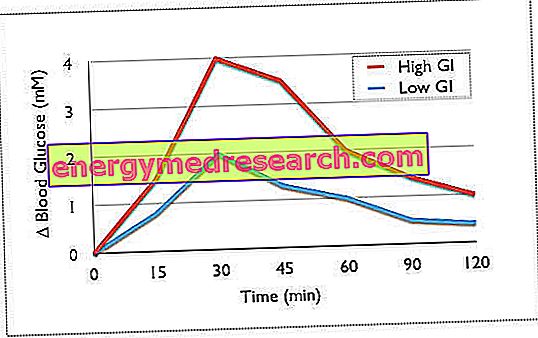Edited by Daniele Todaro
I would like to explain in this article two very important factors for feeding a sportsman (and not only), I will try to do it with very simple words without going into too much detail that the most interested can find in some texts of biochemistry.
Usually in the field of carbohydrate integration we often hear the following abbreviation "IG" which is no other than the acronym of Glycemic Index.
With much less frequency instead we hear another acronym "CG", this indicates the Glycemic Load of a food, a very important factor to which little space is given, perhaps due to lack of information or perhaps due to the fact that the simplest roads to go are the most attractive ones.
Let us now start by degrees, carbohydrates are divided into three categories: monosaccharides, disaccharides which, as the term suggests, will be simple sugars, and polysaccharides which instead
they will be complex sugars.
Their difference is given by the group of molecules linked together, the monosaccharides contain one
sugar molecule, the disaccharides contain two, while the polysaccharides are formed by multiple bonds of monosaccharides.
Monosaccharides: glucose, fructose (let's simplify it because we should get into some biochemical procedures to describe the units that make up monosaccharides).
Disaccharides: sucrose, lactose, maltose.
The most important polysaccharides are: cellulose, amylose, amylopectin, glycogen.
Once ingested, the carbohydrates undergo a transformation within our intestines, all of which are broken down into monosaccharides to give way to pass through the intestinal wall and enter the bloodstream where they reach the liver which will transform them into glucose.
Glucose can be returned to the body for energy or transformed and stored in the form of glycogen if there is already enough in the body; the remaining glucose will be converted into fat.
The glucose present in the blood stream will be regulated by the pancreas which will secrete two hormones, glucagon and insulin; the increase in blood sugar given by taking an excessive dose of carbohydrates will be rebalanced by insulin, hence the origin of the famous "insulin peak", which will increase proportionally to the glycemic index of the carbohydrates consumed.
But what is IG (glycemic index) or better yet, first of all, what is glycaemia?
Blood sugar indicates the presence of glucose in the blood stream, so there will be a glycemic response which will indicate the enrichment of blood sugar following the intake of certain types of carbohydrates.
To make this comparison we will consider a type of carbohydrate "proof" that is usually glucose (index equal to 100), which will provide values that will allow to verify the type of impact that carbohydrates will have with respect to the concentration of sugars in the blood stream.
The glycemic index will therefore be given by the speed with which the blood sugar level will increase following the intake of 50 g of the carbohydrate being tested.
This index will be expressed as a percentage, putting it in relation to the speed of increase of the carbohydrate "test" blood glucose and using the same quantities.
Logically we could understand that a glycemic index of 50 will indicate that the food raises the blood sugar with a speed that is half that of glucose.
Small note: pay attention to the tables showing the glycemic indexes of food, first of all look at what type of food has been used as "proof", not all of them are the same.

We now come to the CG (glycemic load), the one who saved us from some serious errors that had been made regarding the glycemic index (IG); many foods were seen as damaging to their high GI because they only paid attention to the quality of the food but not to the quantity.
It was therefore seen that the responses of insulin were not regulated only by the type of food taken but rather by the quantity ingested; athletes usually see fructose as a slow-release energy source that can cover protracted physical efforts, in this way they take exaggerated doses of pre-workout drinks based on this element; on the contrary glucose would be the element to be taken immediately after the workout because this would provide an immediate energy source to restore the energy reserves of the physically subjected to stress.
The trivial example to understand the importance of the glycemic load is precisely in its calculation method; the glycemic load (CG) is measured by multiplying the IG of the food by the quantity assumed. In a nutshell it will be noted that 50 g of fructose (IG = 20) will have a higher glycemic load against 10 g of sucrose (IG = 66).
Fructose: 20x50 = 1000
Sucrose: 10x66 = 660
We are therefore careful to dose carbohydrates and above all to understand that one of the main points lies precisely in the quantity assumed.
Furthermore, most of the employees continue to propose a clumsy classification of sugars, dividing them into two fundamental categories, those of rapid absorption and those of slow absorption; it is therefore considered that a low glycemic index would correspond to an absorption by the slower organism, thus causing a lower glycaemia and a longer duration in time, WRONG!
Probably confusion has been made regarding the speed of gastric emptying, which in fact varies between the various carbohydrates, and the time needed for glucose to enter the bloodstream.
Many studies, no longer based on purely theoretical but practical procedures, have clearly shown that the glycemic peak appears at the same time for all carbohydrates; the time required will be around 25-30 minutes depending on the type of carbohydrate taken on an empty stomach, whether it is simple or complex.
As you can see, the variation will be only 5 minutes, a negligible amount of time compared to the approximately 3 hours, necessary to complete digestion.
Scientific conferences have tried to change the mistaken belief about these theories embraced by numerous nutritionists, the food company, doctors and dieticians; unfortunately it is not easy to succeed in this endeavor, for marketing reasons and consequent revolutions that would distort some fundamental dogma now assimilated by most individuals and professionals.
Obviously all this also spills over into the sports environment, where they have been adopted for years
protocols completely wrong and ineffective for the usual reason related to the business and the lack of desire to carry out research activities.
REFERENCES:
R. Albanesi
DJA Jenkins
G. Slama
T. Wolever
I mentioned some of the main researchers on what is written in this post, I did not include the bibliographic list which includes dozens of texts related to the studies in question.



